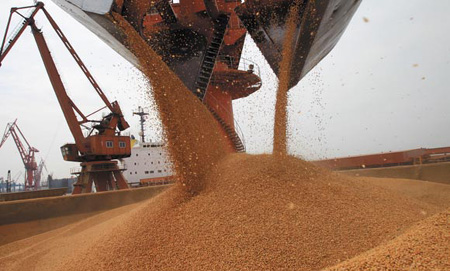Prime
Trade figures present 'a distorted picture'
Updated: 2011-05-09 10:54
By Wang Xing (China Daily)
|
Imported soy bean is offloaded from a cargo ship at a Chinese port in this file photo. China posted a trade deficit of $1.02 billion in the first three months of this year, the first quarterly deficit in seven years. Xu Congjun / for China Daily |
Beijing - Many US politicians claim that cheap products imported from China have squeezed many US citizens out of jobs, but industry analysts say the truth may be just the opposite.
According to a recent research, Chinese workers contributed only a small amount to China's huge trade surplus with the United States, meaning that it is US companies and consumers that have benefited the most from cheap Chinese labor and goods.
Xing Yuqing and Neal Detert, researchers at the Asian Development Bank Institute, a think tank in Tokyo, said in a research note published early this year that the traditional ways of measuring global trade present "a distorted picture", which fails to reflect the true complexities of global commerce.
They cited Apple's iPhone as an example. In trade statistics the iPhone is considered a Chinese export to the US, although the popular smartphone is actually designed and owned by a US company and is composed of parts produced in several Asian and European countries.
"Most of the bilateral deficit associated with the iPhone did not originate in China, as Chinese workers contribute a very small portion of the added value to an iPhone sold in the market," Xing and Detert said.
They pointed out that the estimated $178 wholesale cost of the shipped phone was credited to China under the current approach to trade measurement, even though the value of the work performed by Chinese workers accounted for just 3.6 percent, or $6.50, of the total.
Xing and Detert said globalization has created a situation where the high-tech products invented by US companies do not increase US exports, "but, to the contrary, exacerbate the US trade deficit".
"What we call 'Made in China' is assembled in China, but what makes up the commercial value of the product comes from numerous countries," said Pascal Lamy, director-general of the World Trade Organization in a speech in October 2010.
Although it is hard to estimate the real trade figures between the US and China, Lamy said if trade statistics were adjusted to reflect the actual value different countries contributed to a product, the size of the US trade deficit with China would be drastically reduced.
Although some US politicians criticize China's trade surplus with the US, many US technology firms have actually contributed, at least part of the huge trade surplus, as is reflected in their increasing investment in manufacturing capacity in China.
In 2009, California-headquartered Hewlett-Packard Co, launched a new laptop-manufacturing base in Chongqing in Southwest China, with an annual production capacity of 24 million units, while its competitor, Texas-based Dell Inc, launched its second operation center in neighboring Chengdu, Sichuan province, in August last year.
These investments helped China's exports of computer products grow 42 percent year-on-year to $197 billion in 2010, compared to only 13-percent growth in China's PC market in the third quarter of last year.
"If US high-tech companies were to share their profits with low-skilled US workers by keeping assembly jobs in the US, it would be a more effective way to reduce the US trade deficit as currently calculated than by only targeting the exchange rate policy of China," said Xing and Detert in the report.
However, Zheng Xinli, vice-president of the China Center for International Economic Exchanges, said many of Chinese exports to the US are those that would be too expensive to manufacture in the US. He said the best way for the US to reduce its trade deficits would be to allow more exports to China.
According to China's General Administration of Customs, trade between China and the US was $385 billion in 2010, up 29.2 percent year-on-year, while China's trade surplus with the US was $181 billion for the same period.
China's trade surplus has narrowed in recent months as the government has tried to reduce its reliance on exports by boosting imports and domestic consumption.
China Daily
(China Daily 05/09/2011 page2)
Specials

2011 Sino-US Dialogue
China and the United States will hold the third round of the Strategic and Economic Dialogue from May 9-10 in Washington.

Bin Laden dead
The world's most wanted man was killed in a US raid in Pakistan.

US-style sports camp
The US sports camp company, Camp Woodward, will open its first residential camp in Beijing in June.
